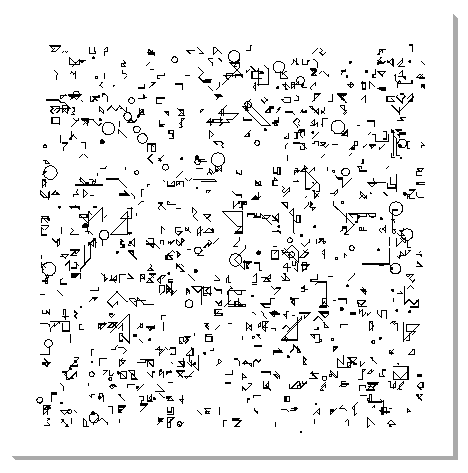Research about Manfred Mohr
Manfred Mohr is a pioneer of digital art. I saw his work in V&A museum. His attitude for computer generated art is convincing and similar with me.
As he said,
I write computer algorithms i.e. rules that calculate and then generate the work which could not be realized in any other way. My artistic goal is reached when a finished work can dissociate itself from its logical content and stand convincingly as an independent abstract entity.
Data and algorithms could be visualize, and computer can operate thousands of programmer to render the image that definitely hard to draw by hand. In addition, Mohr thought about the deeper form of digital art. His algorithms can render shape by particular way and create new composition of shape which means every elements exist in work could be different in composition and any other details. LOOKS COMPUTER COULD BE THINKING. Actually computer can’t thinking now, it merely doing something that have been set, but it can control variable to make every elements have tiny differences.
Early work
My early artistic work was influenced by atonal music, modern Jazz and abstract expressionism. As a consequence, geometry and the reduction of my visual vocabulary to black and white as binary decisions, took more and more importance in my work after 1963.
As he said, he was inspired by atonal music and expressionism. It is really interesting, for me, music and expressionism both are emotional and abstract objects which are hard to describe by words or logical. But Mohr expressed these objects by computer, which have strict ruler and grammar in programmer. So, there is strong contrast in his work, because he used rational object convert to abstract information.
Here are some early test of work and experiment of him:

- (Photo1) In this work, I can find his intention of express music and atone. To convey the unregulated and unordered tone, he drew some crooked border lines to represent tone in stave. I can guess it could the reason he used computer to draw random objects. In his drawing, I can see the difficulty of drawing absolutely random things, at most time we draw something with the order of brain, and the order generally is informative and conceive.

(Photo2) This work showed a construction of lines. A nylon stocking is tear up and put on board. It shows different density of lines and negative space. To control the density of order, repeat and innocence thing can convey specific information.
In 1969-1972, Mohr began to design algorithms to express his work. Image was printed by plotter which can be controlled by algorithm.
A number of printer control languages were created to operate pen plotters, and transmit commands like “lift pen from paper”, “place pen on paper”, or “draw a line from here to here”. Three common ASCII-based plotter control languages are Hewlett-Packard’s HP-GL, its successor HP-GL/2 and Houston Instruments DMPL. Here is a simple HP-GL script drawing a line :
SP1;
PA500,500;
PD;
PR0,1000;
PU;
SP;
This program instructs the plotter, in order, to take the first pen (SP1 = Select Pen 1), to go to coordinates X=500, Y=500 on the paper sheet (PA = Plot Absolute), to lower the pen against the paper (PD = Pen Down), to move 1000 units in the Y direction (thus drawing a vertical line - PR = Plot Relative), to lift the pen (PU = Pen Up) and finally to put it back in its stall.
As we can see, early plotter has strict ruler and logical grammar. It should be given some order and parameter to draw image.
data and parameter could convert to informative shape,
can shape or words return to data? So it might be reconstructed and convey new means?
In this idea, Chinese word could be dissociated to different stroke, pronunciation, stress and component which group up a word. In Chinese word, there are 4 stresses in pronunciation ruler, and most of character components (PianPang) have specific meanings, thats means, a Chinese word can be separated to be different words and meaning. Though it will lose the accuracy expression, it still convey part of original meaning and excess meaning. In later day, I would do deeper research about separation of Chinese character.

- (photo3) This work is made from vertical and horizon line, the horizon one is thicker so we can clear see that continuous line changed the direction. Actually the trace of line is random and controlled by algorithms. how long it go straight, how it change direction, when? The algorithms operate plotter to draw this image. It could be really interesting if we printed hundreds of it, the random walk of line, like a creature, smart and fool.

- (photo4) Random and variable can make complex composition, there are infinitive possibilities can be render, but the ruler is not changed, and the visual grammar is both same. In this point, the shape merely as a outcome, the algorithms could be art finally. A designer do not just create shape, it support a ruler, a model, a code.
The elements are horizontal, vertical, 45 degree lines, square waves, zig-zags, and have probabilities for line widths and lengths.
In each position on a very dense imaginary matrix, a sign is composed from 0-7 elements from the above alphabet.
When 0 lines are chosen, a circle can be drawn having a randomly chosen radius and center.
An image system in film could be made from similar elements, such as shape, structure and colours. These things combine with each other in an obscure (not obvious) way, but it indeed support a feeling or key that make all of elements connected. In addition, it makes association, because its ruler, grammar, way of composition. Using of image system in film factory
Similar with image system, a computer-generated image could be made from series of elements which could be really simple, they group up with specific layout, and changed size or width, etc..